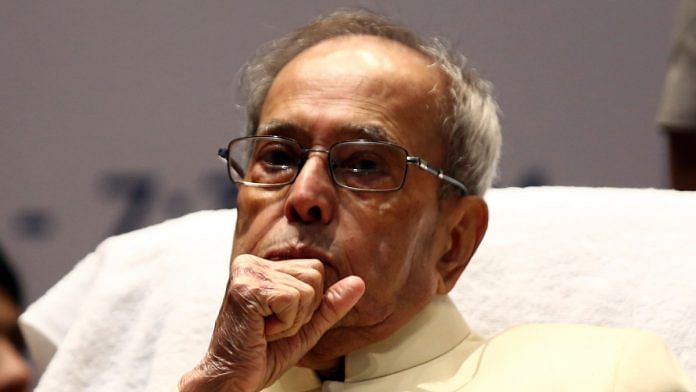New Delhi: Former President Pranab Mukherjee’s visit to a Rashtriya Swayamsevak Sangh (RSS) training camp had created quite a flutter two years ago. The reason: For most of his political career, Mukherjee he had been a senior leader of the Congress, which is perceived to be anti-Sangh by most political pundits. And this perception isn’t without reason as the Congress has banned the RSS thrice — in 1948, in 1975 and in 1992.
However, Pranab Mukherjee’s visit to the RSS event in Nagpur on 7 June 2018 wasn’t an exception. Many leaders cutting across political lines, including Congress stalwarts, have been associated with the RSS or have been in touch with it since its inception in 1925.
In fact, almost eight-and-a-half decades before Mukherjee’s visit, Mahatma Gandhi had visited an RSS training camp at Wardha in 1934. On 16 September 1947, while addressing RSS workers in one of his speeches in Delhi, Mahatma recalled, “I visited the RSS camp years ago, when the founder, Shri (K.B.) Hedgewar, was alive. I was very much impressed by your discipline, the complete absence of untouchability, and the rigorous simplicity. Since then, the Sangh has grown. I am convinced that any organisation, which is inspired by the high ideal of service and self-sacrifice, is bound to grow in strength.”
Dr Bhimrao Ambedkar visited an RSS training camp — the Sangh Shiksha Varga — at Pune in 1939. When Dr Ambedkar asked Dr Hedgewar whether there were any untouchables in the camp, the RSS founder replied that there were neither touchables nor untouchables, but only Hindus there.
Ambedkar said, “I am surprised to find the swayamsevaks moving about in absolute equality and brotherhood without even caring to know the caste of the others.”
In the 1950s, Ambedkar and RSS pracharak Dattopant Thengadi worked together closely and were constantly in touch.
Also Read: Pranab Mukherjee was like a guide to RSS, says chief Mohan Bhagwat
RSS ‘has historic role to play’
Prime Minister Jawaharlal Nehru, who was initially quite critical of the RSS, invited the organisation to participate in the Republic Day parade of 1963. The invitation was extended in recognition of the stellar work done by RSS volunteers during the 1962 India-China war. A 3,000-strong contingent of RSS volunteers participated in the Republic Day parade that year.
In 1965, when Pakistan attacked India, the then Prime Minister Lal Bahadur Shastri invited the second sarsanghchalak of the RSS, M.S. Golwalkar, for an all-party consultative meeting, though the RSS was a non-political entity.
Golwalkar was travelling through Maharashtra and was stationed in Sangli for organisational work when he received this message. He immediately flew to New Delhi to attend the meeting.
Socialist and revolutionary leader Jayaprakash Narayan visited an RSS training camp in Patna on 3 November 1977, where he said in his speech: “Sangh (RSS) is a revolutionary organisation and right now there is no other organisation in the country which come even close to it… (it) alone has the capacity to transform society, end casteism and wipe the tears from the eyes of the poor. Its very name is ‘rashtriya’, that is national. I am not saying this to flatter you. I believe you have a historic role to play…. I have great expectations from this revolutionary organisation which has taken up the challenge of creating a new India.”
Earlier, in the 1960s, a host of leaders visited and appreciated the Vivekananda Rock Memorial at Kanyakumari that was set up under the guidance of RSS pracharak and former sarkaryavah Eknath Ranade.
The then President V.V. Giri inaugurated the celebrations after the memorial was completed. The then Prime Minister Indira Gandhi visited it after a fortnight of its inauguration. She addressed a meeting of the memorial organising committee, whose secretary was Ranade. The latter also presented a report after the PM’s address.
Prime Minister Indira Gandhi commented during her visit, “It is a moving experience to come to Kanyakumari and see how the faith of thousands in Swami Vivekananda’s message has made possible this memorial. May it inspire all who visit it and give them the courage to live up to Swamiji’s great and timeless teachings.”
In the 1980s, an organisation called the ‘Virat Hindu Samaj’ was set up to launch an anti-conversion campaign after many Dalits converted to Islam in Tamil Nadu’s Meenakshipuram. Well-known Congress leader Dr Karan Singh, a former member of the Indira Gandhi Cabinet, was the president of this organisation, and the general secretary’s post was held by Ashok Singhal, who was the prant pracharak of the RSS in Delhi.
This Samaj organised a massive conference of Hindus in New Delhi that was attended by around 5 lakh people. In addition, hundreds of small and big conferences were organised throughout the country. Singhal later played a stellar role in the Ram Janmabhoomi movement launched by the Vishva Hindu Parishad (VHP).
(Information used in this report has been sourced from the book, The Saffron Surge:Untold Story of RSS Leadership and RSS archives)
The writer is associated with RSS. He is research director at think-tank Vichar Vinimay Kendra. He has authored two books on the RSS
Also Read: Pranab Mukherjee — ‘man who knew too much’ but was a Rahul Dravid-like ‘wall’ for Congress




Nehru and RSS are like north pole – south pole.